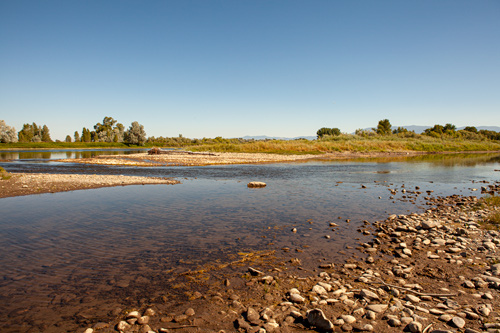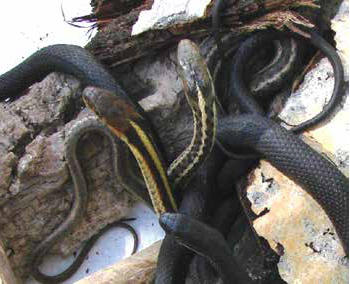Lewis commandeers the boats up the swift Missouri River. He sees black garter snakes and hoists flags on each canoe to signal any nearby Shoshones. His group camps near present Townsend, Montana.
Clark scouts ahead, fails to find any Shoshones, and camps near present Toston.
In New Orleans, the Louisiana governor writes about the Fort Mandan specimens.
Missouri River near Townsend, Montana
© 23 July 2013 by Kristopher K. Townsend. Permission to use granted under the Creative Commons Attribution-Share Alike 4.0 International license.
Deer Hunting
I Set out by land at 6 miles overtook G Drewyer who had killed a Deer. we killed in the Same bottom 4 deer & a antelope [Pronghorn] & left them on the river bank for the Canoes
—William Clark
No Sign of Indians
proceeded on an Indian roade through a wider Vallie which the Missouri Passes about 25 miles & Camped on the bank of the river . . . . I Saw no fresh Sign of Indians
—William Clark
Tough Towing and Poling
we made great uce of our seting poles and cords the uce of both which the river and banks favored. most of our small sockets were lost, and the stones were so smooth that the points of their poles sliped in such manner that it increased the labour of navigating the canoes very considerably, I recollected a parsel of giggs which I had brought on, and made the men each atatch one of these to the lower ends of their poles with strong wire, which answered the desired purpose.
—Meriwether Lewis
Black Garter Snakes
I saw a black snake today about two feet long the Belly of which was as black as any other part or as jet itself. it had 128 scuta on the belley 63 on the tail.[1]See “The Lewis and Clark Expedition and the Townsend Black Snake” We Proceeded On, https://lewisandclark.org/wpo/pdf/vol43no1.pdf#page=31.
—Meriwether Lewis
Whitehouse (Gurnett) Creek
passed a large creek on Lard. side 20 yds. wide which after meandering through a beautifull and extensive bottom for several miles nearly parallel with the river discharges itself opposite to a large cluster of islands which from their number I called the 10 islands and the creek Whitehous’s Creek, after Josph. Whitehouse one of the party.
—Meriwether Lewis
Hoisting Flags
I ordered the canoes to hoist their small flags in order that should the indians see us they might discover that we were not Indians, nor their enemies.
—Meriwether Lewis
Weather Diary
State of the thermometer at rise
Weather at rise
Wind at rise
State of the Thermometer at 4 P.M. Weather at 4 P.M. Wind at 4 P.M. State of the river 54 [above 0] fair S W. 80 [above 0] cloudy S W fallen ½ in. he sets out again this morning
—Meriwether Lewis[2]To assist the reader, the editor of this web page has omitted the date column, merged the “State of the river” columns, and spelled out some abbreviations.
Specimen Shipment
(Private)
New Orleans July 23rd 1805
Sir,
I have taken the Liberty to address to your care one Hoggshead three Boxes and two Cases directed to the President of the United States and which were this day put on Board the Ship Commet Captain McNeal bound for Baltimore. The Hoggshead & Boxes Contain curiosities which were collected by Captain Lewis in his Voyage up the Missouri: in one case is a living animal called the wild dog of the Prairie, and in the other are four Birds, called the Missouri Magpies.
Wm. C. C. Claiborne[3]“William Claiborne to the Collector at Baltimore” in Letters of the Lewis and Clark Expedition with Related Documents: 1783–1854, 2nd ed., ed. Donald Jackson (Urbana: University of … Continue reading
Notes
| ↑1 | See “The Lewis and Clark Expedition and the Townsend Black Snake” We Proceeded On, https://lewisandclark.org/wpo/pdf/vol43no1.pdf#page=31. |
|---|---|
| ↑2 | To assist the reader, the editor of this web page has omitted the date column, merged the “State of the river” columns, and spelled out some abbreviations. |
| ↑3 | “William Claiborne to the Collector at Baltimore” in Letters of the Lewis and Clark Expedition with Related Documents: 1783–1854, 2nd ed., ed. Donald Jackson (Urbana: University of Illinois Press, 1978), 253. |


